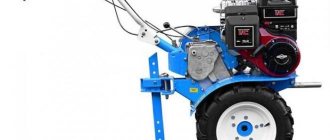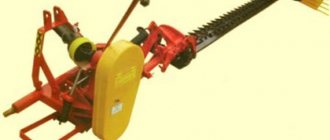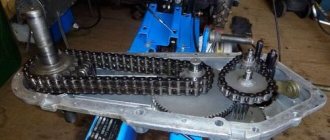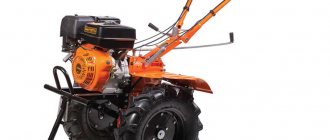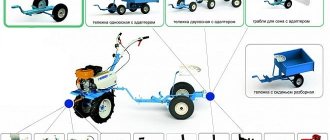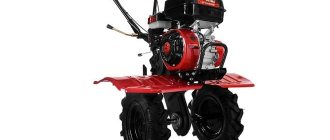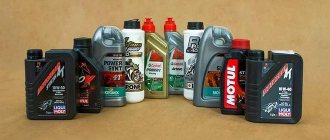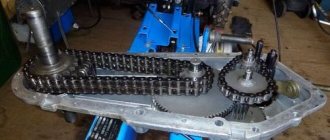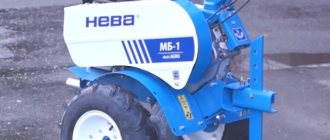As you move and collect snow, it will flow into the auger body, move to the center, where it will be picked up by the plate and thrown out through the snow chute. If you just need to move the walk-behind tractor from one place to another and do not use attachments, it will be enough to loosen the belt tension. Consider the fact that snow is thrown a considerable distance and with sufficient force. Therefore, watch out for glass in windows and other breakable objects. If anything gets stuck in the unit, you must turn off the engine and only then begin cleaning.
There are some rules for working with a snow blower:
- Preliminarily inspect the area you want to clear of snow. If there are any objects, stones, debris on it, you need to remove it all so that nothing gets stuck in the device;
- Snow flies out of the gutter over a long distance, so there should be no people or breakable objects nearby;
- Look after yourself too. You should not wear long items of clothing, such as a scarf, that could wrap around the blades of the device. The same applies to everyone who is nearby;
- The unit should be used on relatively flat surfaces. Do not use where there are steep ascents and descents;
- Take breaks from work so that, firstly, the walk-behind tractor is not overloaded, and secondly, so that you have the opportunity to periodically clear the device of accumulated snow.
Advantages of the snowmobile attachment to the walk-behind tractor of the Neva brand
The prefix has a lot of advantages. As is clear from all of the above, it can become an indispensable assistant in winter, when you need to clear a large area. The advantages include the following indicators:
- simple controls. You just need to correctly attach the attachments, adhere to the operating rules, and simply drive the machine around the territory;
- economy. Fuel consumption is minimal;
- resistance to negative environmental influences;
- reliability and strength;
- durability.
The prefix has a lot of advantages. As is clear from all of the above, it can become an indispensable assistant in winter, when you need to clear a large area. The advantages include the following indicators:
- simple controls. You just need to correctly attach the attachments, adhere to the operating rules, and simply drive the machine around the territory;
- economy. Fuel consumption is minimal;
- resistance to negative environmental influences;
- reliability and strength;
- durability.
It is also worth noting the fact that the domestic walk-behind tractor and its accessories are quite affordable, and almost every farmer can afford them, regardless of income level. Plus, you can make it yourself.
Models of snow blowers for the Neva
There are different models of snow blowers for the Neva walk-behind tractor on sale. It is important to choose a tool that will ideally suit your type of unit. The technical specifications that you will find in the instructions for the equipment will help you with this, as well as the sellers who will advise you on the best option.
- Snow blower for the Neva walk-behind tractor, model MB2. Model MB2 is not even a model of a snow blower, but a model of the walk-behind tractor itself. It’s just that such a tool on sale is an attachment specifically for this particular machine model. It is capable of covering an area 70 centimeters wide and a snow height of 20 centimeters. Snow will fly up to 8 meters away. The mass of the tool is 55 kilograms, and the operating speed is up to 4 kilometers per hour.
- Model SM 0.6. This tool is smaller in size and has lower productivity. In addition, the design has a gear auger, but this does not change the operating principle. The width of snow capture is 56 centimeters, and the height of snow that the unit is capable of capturing is 17 centimeters. Snow is thrown at a distance of up to 5 meters, and the mass of the tool is 55 kilograms.
- Model SMB-1. The screw has a screw belt. The snow capture width is 70 centimeters, and the height is 20 centimeters. Snow is thrown at a distance of 5 meters, and the mass of the unit is 60 kilograms.
- Model SMB N. Auger has screw metal parts. The width of the treated area is 70 centimeters, the height of snow capture is 20 centimeters. Snow is thrown at a distance of 5 meters, the total weight of the unit is 60 kilograms.
You attach all attachments to the main machine. Moreover, many craftsmen do not want to spend money on purchasing tools and make their own attachments from scrap materials. You can find suitable diagrams on the Internet and try to make an instrument.
Specifications
The Neva MB 2 walk-behind tractor is made according to the traditional design for this segment.
Dimensional parameters of the model:
- length – 1740 mm;
- width – 650 mm;
- height – 1300 mm;
- standard gauge – 320 mm;
- track with axle extensions – 567 mm;
- ground clearance - 140 mm;
- minimum turning radius – 1100 mm.
The structural weight of the equipment is 98 kg, the operating weight is up to 200 kg. The maximum transport speed is 12.96 km/h. The angle of lateral static stability for the Neva MB 2 model is 15 degrees.
Performance characteristics of the equipment:
- cutter diameter – 360 mm;
- tillage depth – up to 200 mm;
- maximum working width – 1200 mm;
- processing speed – up to 0.12 ha/hour.
Fuel consumption
The fuel tank of the walk-behind tractor holds 3.6 liters of fuel. Specific fuel consumption for this model is 1-1.6 l/hour.
The Neva MB 2 walk-behind tractor is equipped with various 4-stroke 1-cylinder carburetor engines with manual start from the starter (retractable cord) and air cooling. The power plant is fixed to the frame with special bolts. A three-groove pulley is used to transmit rotation to the attachment or gearbox. It is recommended to regulate engine operation during initial start-up using the air damper.
The Neva MB2K model is powered by a domestic engine, the DM-1K model. Its manufacturer is the Red October enterprise. This power plant is characterized by overhead valves, a horizontal crankshaft and high torque. The engine has a displacement of 0.317 liters and a power of 6.5 hp.
Some modifications of the walk-behind tractor are equipped with imported units. The most popular models here are those with the Robin-Subaru EX21 power plant (rated power - 6.5 hp, rotation speed 3600 rpm) and the Briggs&Stratton rated unit (power 5.5 hp).
The engines of all modifications of the walk-behind tractor have the following features:
- the presence of a ball bearing in the main crankshaft supports. They ensure smooth operation of the engine;
- the presence of a repairable cast iron sleeve and a special aluminum block. This solution allows you to maintain the original dimensions of the sleeve for a long period;
- automatic decompressor;
- reliable air filter with double cleaning element;
- low fuel consumption and low noise level due to the overhead valve arrangement;
- advanced ignition system that allows you to start the engine under any conditions.
The Neva MB 2 walk-behind tractor is very popular in our country, which is why a lot of reviews about this model have accumulated.
Equipment owners highlight the following positive aspects:
- The walk-behind tractor plows the soil well and plants root crops without cutting them. The operator does not have to expend additional effort, which greatly facilitates his work;
- the machine always performs the tasks assigned to it. At the same time, little fuel is consumed even at maximum loads. It is profitability that is considered one of the main advantages of the model;
- Neva MB 2 works at any time and in any weather, and there are no “sneezes” or interruptions.
- The walk-behind tractor has compact dimensions, which allows it to fit even in the trunk of a car;
- The machine is highly productive. When working with cutters, 5 acres can be cut in 2 hours. Moreover, the ground becomes smooth and light. Neva MB 2 is perfect for working on a small area of 20-30 acres;
- availability of spare parts. They can be purchased at almost any specialty store;
- Despite the affordable price, the model is of high quality and quickly pays for itself.
The walk-behind tractor also has many negative aspects. Among them are:
- low adaptability to cultivating large areas of land. Neva MB 2 weighs about 100 kg, so even a trained operator’s hands get tired quite quickly. On uneven surfaces, equipment constantly falls and tilts. The model is optimal for milling soft soil;
- It is extremely rare to fully refuel a walk-behind tractor. When the tank is filled to 60-70%, the plugs when working with cutters begin to “shoot” gasoline, which sharply increases fuel consumption. Sometimes fuel leaks appear. The problem can be solved when the tank is not completely filled;
- in winter, modifications with the EX17 power plant are extremely difficult to start. The launch is carried out from 8-9 times. In summer, such problems are not observed;
- the small distance between the wheels and their small size make the Neva MB 2 model unstable. On an uneven surface, the car constantly falls to the side;
- In virgin lands, the tillers of the walk-behind tractor refuse to work. The equipment either jumps out of the ground or buries itself, missing sections of the ground. As a result, the processing comes out in “waves”.
In the total number of reviews, positive assessments of the Neva MB 2 walk-behind tractor predominate, and many of the model’s shortcomings are the result of improper operation. The defect rate at the manufacturing plant does not exceed 1.5%, which indicates the high quality of the equipment. Neva MB 2 is a really good and reliable walk-behind tractor, but it also requires attention and care.
How to make a snow blower for a walk-behind tractor with your own hands
Let's look at how to make a snow blower with your own hands. An attachment to a walk-behind tractor can be quite expensive for the user. Attachments for a walk-behind tractor cost more than 20,000 rubles. In order not to spend a lot of money, you can make a homemade snow blower for a walk-behind tractor. Moreover, make both a rotary snow blower for an all-terrain vehicle with your own hands, and an auger one. To make a snow blower for a walk-behind tractor with your own hands, you can take the drawings on the Internet, and then start assembling.
First you need to define the basic contours of the bucket using small metal angles. The frame is assembled using conventional welding. After this, it needs to be covered with aluminum or iron sheets. Remember that if you use aluminum, it must be additionally secured with rivets and bolts.
For a self-made snow blower for a walk-behind tractor, the rear part of the bucket must receive additional reinforcement so that a connecting element can be installed on it. Installation is carried out using special strips of steel material. From the inside, along the side walls, you need to lay special bushings equipped with bearings for the auger shaft. For this you can use any steel pipe.
In the center and along the pipe it is necessary to make a slot where a metal plate is placed, which will serve as the impeller of the suspended unit and ensure that the snow mass is thrown into the outlet socket.
At the corners of the plate, you need to place lugs in advance in order to subsequently attach screws there. Weld a key on one side of the pipe where the sprocket for the transmission will be installed. In order for the key to be brought out, a hole must be made in the wall. After this, a snow removal auger is made: 2 pairs of rings are cut out of steel sheets, one side of each is cut so that they can be opened.
The rings must be welded by circling them around the shaft. In order for the snow mass to be crushed, it is necessary to provide the rings with beveled teeth. At the end, install the socket, for which a steel pipe is fixed on the turntable.
The inlet must be securely fixed; a good fan must be installed at its inlet, the role of which can be played by an old car heater. In order to recharge the unit, it is necessary to install a generator that converts the power obtained from the rotation of the shaft into electricity. Make a mount at the back of the bucket on which snow removal equipment will be hung.
The answer to the question of how to make a rotary snow blower for a walk-behind tractor with your own hands can be found on the Internet, including a video recording of the process. Drawings of a snow blower for a walk-behind tractor with your own hands are freely available. Attachments for walk-behind tractors and walk-behind cultivators, designed as a snow blower, will help cope with heavy snowfalls and clear the area of snow drifts. Removing snow with a walk-behind tractor significantly saves time and labor costs.
Technical characteristics of the Neva walk-behind tractor
Motoblocks "Neva" have gained popularity among the population, primarily for their reliability and build quality; the percentage of defects at the enterprise does not exceed 1.5%. The machine has a good margin of safety, thanks to high-quality materials and high-tech processing methods.
The device has 2 forward speeds and 1 reverse, there is also a lower row, for this you will have to transfer the belt to another pulley. Travel speed from 1.8 to 12 km/h. The heaviest model produced weighs 115 kg, and the weight of the transported cargo can be up to 400 kg.
Engine of the Neva walk-behind tractor
To complete its walk-behind tractors, it uses DM-1K engines made in Kaluga and engines of famous world brands “Honda”, “Subaru”, “Briggs&Stratton” of various power.
Gearbox of the Neva walk-behind tractor
The Neva gearbox is gear-chain, sealed, in an oil bath, and is distinguished by its reliable design. Lightweight and durable body made of aluminum. Such a gearbox develops a force exceeding 180 kgf and is capable of ensuring reliable operation on all types of soils.
A nice addition is the axle decoupling mechanism, which allows you to direct the drive to only one wheel, thereby greatly facilitating control.
Transmission of the Neva walk-behind tractor
Torque from the engine to the gearbox is transmitted using a V-belt drive with a tension roller. This design is time-tested, not expensive to implement, simple and reliable. If the walk-behind tractor during operation encounters an obstacle with the working elements of the hitch, the belt will simply begin to slip, thereby protecting the engine and gearbox elements from damage.
Some more tips from the owners
By searching the forums for information about the snow blower for Neva walk-behind tractors, you can find some tips on how to work with the equipment correctly. Below are some of them. These tips are written by people who already have experience working with a snow blower:
- If it is necessary to carry out long-term snow removal work, every five hours you should check whether the chain is tensioned. But before this, it is imperative to turn off the engine and carry out inspection only after stopping the rotating parts. If necessary, tighten them using special bolts;
- You cannot immediately begin long-term snow removal. After starting the snow thrower for the Neva walk-behind tractor, you should let it run for 30 minutes. Then stop its operation and check that all fasteners are tightly tightened. If necessary, re-tighten them.
- Before starting, the clutch handle should be in the disengaged position;
- Do not tighten the belt with great force and create overvoltage; it may be damaged and broken;
- Before you start working, you need to set the SMB snow blower to the Neva walk-behind tractor to “idle” and warm up for several minutes. Likewise, upon completion of the work, it must work for some more time in order to remove any remaining snow. Otherwise, it may turn into ice and make it difficult for the snowblower to operate the next time it is started.
Review of models of walk-behind tractors "Neva"
All modifications of the MB-2 walk-behind tractor differ essentially only in the installed engine. Otherwise, the design remains unchanged, only minor modifications are possible.
- MB-2K - the letter K in the name means that this model is equipped with domestic Kaluga-made engines "DM-1K" of various powers. Semi-professional 6.5 hp and professional with a cast iron sleeve 7.5 hp.
- MB-2B - here the letter after the two indicates that the walk-behind tractor is equipped with professional Briggs & Stratton power units. These engines are also divided into semi-professional and sleeved professional with the prefix PRO in the name. Models power 6; 6.5; 7.5 hp
- MB-2S - this modification is equipped with engines from the famous Japanese. These are reliable, professional, overhead camshaft units EX-17D 6hp. and EX-21D 7hp
- MB-2N - with a Honda engine with a power of 5.5 and 6.5 hp. These engines use the most modern developments of the legendary Honda, have excellent efficiency and high torque. Thanks to this, despite the low power, they ensure durable and reliable operation of the entire unit.
- MB-23 is a series of heavy walk-behind tractors with a powerful output of 8 to 10 hp. engines. In the name, the letter after the numbers, just like the middle ones, indicates “Honda”, “Briggs&Stratton”. The machines are designed for long-term, intensive work on any type of soil, the cultivation depth of which, on these machines, is increased to 32 cm.
Particularly noteworthy is the only model MD-23SD with a Subaru diesel engine with a power of 5.5 and 7 hp. Despite the low power, due to the fact that it is a diesel engine, the model is the most powerful among the MB-23 line.
Principle of operation
The principle of operation of a walk-behind tractor with this equipment is quite simple. The walk-behind tractor is adjusted to the snow blower, the trailing rod is inserted into the pipe and secured with a bolt. Next, take the V-shaped drive belt and put it on the pulleys of the walk-behind tractor and the drive mechanism of the snow blower. The tensioning mechanism ensures proper belt tension.
After starting the walk-behind tractor, rotation from the crankshaft is transmitted via a belt to the snow blower pulley. As this pulley rotates, it also rotates the drive sprocket, which in turn rotates the auger sprocket through the chain.
Moving while cleaning the auger belt, the snow entering the auger body is moved to the center, where it is captured by the plate and thrown out through the snow outlet.
If the use of the snow blower is not necessary, for example, when moving to a cleaning site, it is turned off by loosening the belt tension.
Attachments for walk-behind tractors "Neva"
To cultivate the soil, cutters are installed on the Neva walk-behind tractor instead of wheels. Their number, depending on the type of soil, can reach eight pieces. The basic kit includes 4 cutters, additional cutters are purchased separately.
To plow with a walk-behind tractor, you will have to purchase a plow and a special hitch-mount. You will also need metal wheels with lugs for better traction with the soil.
For hilling, single-row and double-row hillers are used, which can also be divided into unregulated and adjustable. It is necessary to choose a hiller based on the quality and composition of the soil. Metal wheels of increased diameter with lugs are used with hillers; this allows increasing the agrotechnical clearance.
To mechanize planting potatoes using the Neva walk-behind tractor, it is recommended to use potato planters KS-1, KS-1A, KST-. This not only facilitates the planting process itself, but also creates the necessary conditions for further inter-row processing and harvesting using attachments. This is facilitated by an even planting and fixed row spacing. The average productivity of such planters is 0.2-0.25 hectares per hour, the distance between tubers is maintained at 25-30 cm, and the width between the rows is adjusted by the track of the unit within 60-70 cm.
There are two types of potato diggers for the walk-behind tractor we are considering:
fan and vibrating (screen type). The use of both is quite justified in small areas and fully cope with their responsibilities.
- Fan diggers for deepening and cutting the soil have a solid metal knife at the base, and metal rods fan out from the knife. The layer of earth raised with a knife is sifted through the rods, and the potatoes are retained and rise to the surface. The productivity of this type of digger is approximately 0.15 hectares per hour.
- Vibrating or screening potato diggers. The main working elements of such a mounted machine are: a ploughshare and a vibrating grid for sifting the soil. The ploughshare lifts the soil with potatoes onto the grid, and the grid with a belt drive from the walk-behind tractor sifts the soil, leaving clean potatoes on the surface. For the Neva, it is recommended to use models KKM-1, KMU-3, KK-6 and others. The average productivity of such equipment is approximately 0.2 hectares per hour.
Mowers for the Neva walk-behind tractor also come in two types:
- Segmental. with cutting knives made of hardened durable steel, moving progressively in a horizontal plane. They work best on flat surfaces, with cereals and evenly standing grasses. For example, the KN-1.1 mower, the cutting width reaches 110 cm, and the productivity is approximately 0.35 hectares per hour.
- Rotary mowers have recently become increasingly popular, displacing segmented mowers from the market. The working elements here are knives mounted on a rotating disk. Such mowers are not afraid of small uneven surfaces, and thick grass and small bushes are also not an obstacle. The Kaluga mower "Zarya" and "Neva-KR-05" produced are prime examples of this family.
Especially for the Neva, the SMB-1 auger snow blower is produced at the plant that is native to the walk-behind tractor. The auger is designed in such a way that snow moves from the edges to the middle, to the nozzle. The direction of snow ejection is adjusted by turning the snow blower screen, and the skids on the body adjust the cleaning height.
The utility rotary brush is used primarily for removing debris. The 90 cm wide gripper can be installed at an angle of up to 90 degrees. Maximum productivity up to 2200 m/2.
Cart trailer – the load capacity of such a cart reaches 400 kg. Equipped with a driver's seat, brakes and a reliable hitch.
Safety precautions
When turning on the walk-behind tractor with attachments, the following requirements must be met:
- Before starting work, check the reliability of fastening of all elements: auger, bolts, drive, hitch.
- Start the walk-behind tractor at low speeds, from 2 km/h, gradually increasing the speed during operation to 4 km/h.
Loose soft masses are thrown at high speed and over long distances. It is necessary to adjust the direction of their movement in advance using the guide visor on the snow outlet.
Owner reviews of the walk-behind tractor
Reading information on the website of a walk-behind tractor manufacturer or a dealership will never give you a completely objective picture of the equipment. No one in their right mind would criticize their product, even if there is a reason for it. Therefore, we will turn to real Neva users for feedback.
- I purchased a Neva-MB2 walk-behind tractor. Everything that is available is factory produced. For hilling and plowing, I purchased different wheels with lugs, filled them with concrete to make them heavier, now there is no need to push when hilling and autumn plowing. In the spring we mill the area, with additionally purchased cutters the grip is approximately 1.1 m. We plan to purchase a potato planter. In two years of use there were no breakdowns, I am quite satisfied with the purchase.
- Neva with a 6.5 hp engine. I have been using it since 2001. For my 30 acres there is enough, although this is the limit; it is masochism to treat a large area with such a technique. I carry out a full range of work on cultivating potatoes. There were no problems mowing with the Zarya rotor; if you wish, you can make hay for a decent number of livestock. On the trailer it pulled a maximum of 500 kg, if you load it more, it won’t pull it even on the gentlest climb, the weight is too small for this in the walk-behind tractor itself.
- In my opinion, it is too light, it weighs 98 kg and this is clearly not enough; you have to push it when plowing and your hands get tired quickly. On slopes it is very unstable and falls on its side. I think that for light soils it is easier to take a cultivator, but for difficult conditions you need a more serious walk-behind tractor.
- Became the owner of a Neva with a Subaru EX21-7 hp engine. I recently purchased it, but so far my impressions are positive. I deliberately chose a Japanese engine, since I believe that they have no equal in mechanical engineering; it starts with a casual movement of the hand; in general, there can be no complaints about the engine. If you give more revolutions, the gearbox makes a suspicious noise, but God bless it, as long as it doesn’t break. It is difficult to get to one of the engine mounting bolts when the belt is tensioned, this is a minus. I also redid the place where the clutch cable was fixed; the belt was not tensioned well and was slipping; the adjustment did not help. Light weight is also a minus, but the problem is completely solvable; installing weights is not difficult. But overall the device is quite decent.
Motoblock "Neva MB-2" - design, maintenance, characteristics
Among domestic equipment for gardening work, there are representatives who have firmly settled in the minds of landowners as the most versatile and unpretentious models. Among them, the Neva MB 2 K walk-behind tractor stands out - a machine with history and a lot of fans. We suggest studying the description of the model, its features and advantages.
Options and design of walk-behind tractor
Nowadays, the Neva MB 2 walk-behind tractor is available in stores in several configuration options:
- The “MB 2 K” model is equipped with an engine with a long service life and modest fuel consumption;
- The “2MB 2 B” unit is equipped with various imported engines with different power reserves;
- The MB 2 C model is equipped with expensive professional engines from Subaru.
For large areas, it is worth choosing more powerful equipment, and for small ones, the budget version of the MB 2 walk-behind tractor is quite suitable. Be that as it may, the manufacturer of the equipment categorically does not equip it with Chinese engines with low-quality spark plugs and other important parts.
The design of the Neva MB 2 K walk-behind tractor includes a gear-chain type gearbox housed in an aluminum housing. It combines perfectly with a powerful motor, and allows the owner to operate the unit in one of 4 forward and two reverse speeds. In this case, starting from a standstill in second or third gear has virtually no effect on the operation of the spark plugs.
Operating in first gear, the device produces a thrust of 180 kgf. This guarantees uninterrupted use of the model for plowing, hilling and cultivating heavy soil. The standard speed of the unit with a trailer reaches 10 km/h, but with a little modernization this figure can be increased to 12 km/h. A special feature of the walk-behind tractor is its light weight. It weighs just under 100kg, allowing two adult men to load it onto a car trailer.
Unit engine - studying the “heart” of the machine
A reliable walk-behind tractor motor is the key to its uninterrupted operation. That is why this element is worth studying in more detail. Its features include:
- Depending on the configuration, the walk-behind tractor can be equipped with different single-cylinder 4-stroke engines;
- The engine is attached to the frame with special reinforced bolts;
- The transmission of rotation to the attachments is carried out via a pulley;
- When starting to work with the unit, the motor must be adjusted using the air damper. In this case, you must adhere to the operating instructions.
Without completing this simple procedure, the owner of the model faces such troubles as a broken clutch cable. Often, beginners notice that the engine speed fluctuates. The reason for this lies in the need to adjust the gearbox. You can also find instructions for correct settings in the instructions for the walk-behind tractor.
One of the advantages of the unit’s motor is the absence of the need to frequently purchase and replace spare parts - coupled with low fuel consumption, this makes the walk-behind tractor one of the best representatives in terms of price-quality ratio.
Features of the walk-behind tractor
The walk-behind tractor can be used for various jobs. The model performs well when plowing, cultivating soil, watering and planting crops, removing snow, cutting grass and transporting crops.
Among the features of the unit are:
- Increased efficiency when operating with 8 cutters;
- A unique tire tread pattern, thanks to which the wheels themselves throw off the soil and do not sink into the ground;
- Improved gearbox design;
- Modest fuel consumption;
- The presence of a power take-off shaft, which makes it possible to safely connect any equipment.
Any spare part of the model is made conscientiously. In terms of build quality, the model is significantly superior to analogues in its price category.
Dimensions and technical characteristics of the walk-behind tractor
The model is produced according to a completely standard scheme, characteristic of all units from its segment. The dimensions of the walk-behind tractor are:
- Length – 1.74 m;
- Width – 65 cm;
- Height – 1.3 m;
- Standard track – 32 cm;
- Track with axle extensions - 56.7 cm;
- Clearance – 14 cm;
- The lowest turning radius is 1.1 m.
The weight of the unit without additional equipment is 98 kg. Working weight – no more than 200 kg. The maximum speed of the model with a trailer can reach 10.5 km/h.
According to the operating instructions, the unit has the following performance characteristics:
- The diameter of the working cutter is 36 cm;
- Soil plowing depth – 18–20 cm;
- Maximum working width – 1.2 m;
- The maximum plowing speed is up to 0.10 ha/hour.
With its small overall dimensions, the model can be deployed in a garden or vegetable garden with frequent plantings.
pro-motobloky.ru
Motoblock Neva instructions
You can download or view operating instructions for Neva walk-behind tractors of various years of manufacture on this page of the website. The user manual for repairing MB walk-behind tractors will tell you how to independently fix many of the malfunctions of your Neva equipment.
The first Neva walk-behind tractor was released by Krasny Oktyabr-Neva JSC in 1984; many models, manufactured even according to old engineering standards, still serve faithfully to this day, just as well as when they were new.
There is no doubt that walk-behind tractors are of great help when cultivating your plot or garden. They can work 10-20 hours a year and remain operational for many years, freeing you from hard, painstaking manual work.
The big problem is that instructions and manuals for our iron assistants tend to get lost over time. So we've tried to build a library of them in an accessible form in PDF format that's ideal for printing. In fact, you will be more comfortable using printed instructions rather than simply viewing them online.
When purchasing new equipment, you need to familiarize yourself with the main characteristics of the selected model. Studying the instructions for a walk-behind tractor directly in the store before purchasing is not the best option; by downloading the user manual from the website, you can familiarize yourself with all the nuances in a quiet home environment, weigh the pros and cons, compare several models, choosing the most optimal option for yourself. Our website gives you this opportunity.
Download operating instructions for Neva walk-behind tractors
Operating instructions for the Neva walk-behind tractor MB 2B-6.5RS + Briggs&Stratton RS950 (RS 6.5) engine download.
Motoblock "Neva MB-2 subaru" and its modifications MB-2K, MB-2B, MB-2N, MB-2S - operating manual 2013.
Motoblock "Neva MB-1", MB-1D, MB-1R - operating instructions, 1992. Novgorod
Operating instructions for walk-behind tractor Neva MB-1 1986. Leningrad
Motoblock Neva MB-1 user manual 2015
Motoblock "Neva MB-2" operating manual, 1992. JSC Krasny Oktyabr St. Petersburg
Motoblock Neva MB-23 operating manual 2013 JSC Krasny Oktyabr St. Petersburg
Catalog of spare parts for the Neva MB-2 walk-behind tractor with the DM-1K engine, 2009.
Catalog of parts and assembly units of the Neva MB-2 walk-behind tractor with the DM-1K engine, 2005.
Manual for repairing walk-behind tractors type MB OKA, NEVA, CASCADE 1997.
Engine for the Neva DM-1-01 walk-behind tractor and its modifications - instruction manual.
Engine for walk-behind tractor Neva Robin Subaru EX13 EX17 EX21 EX27 - operation and maintenance manual.
Video instructions for assembling and launching the NEVA walk-behind tractor
pahalka.ru
The principle of fastening the Neva snow removal attachment
To couple a snow blade to a walk-behind tractor, you must perform a series of sequential actions:
- Remove the connecting flange on the snow removal equipment;
- Using two bolts, couple the snow removal attachment and walk-behind tractor;
- You should then place the hitch into the bracket located on the trailer. And secure with two bolts;
- Remove the side protection on the power take-off shaft and install the drive belt;
- Install protection back;
- Adjust the tension using a special lever;
- Start using the equipment.
This simple process takes relatively little time. Also, it will not need to be disassembled until the end of winter.
Similar posts
- Robimo do-it-yourself snow blower for a walk-behind tractor How to make a snow blower with your own hands for a walk-behind tractor, chair, photo, video How to choose a factory snow blower for a walk-behind tractor Snow removal equipment for walk-behind tractors
Self-propelled electric snow blower &# 8212; very handy and cheap DIY tool
As winter approaches, snow begins to fall. For rich people living in private plots, clearing snow is a big problem. When working with a shovel, you can spend a lot of energy and hours, but the result will still not be ideal.
To help people, snow blowers were built (Div. Yak vibrati). However, their price is often too high for people. This is due to food: how to make a snow removal machine with an electric motor with your own hands?
How does a snow blower work?
Let's look at the operating principle of a snow blower. A mounted snow blower for a walk-behind tractor is equipment that does not remove snow on the sides of the road, but, on the contrary, picks up the snow and transfers it to the auger. Such equipment is a combination of two pairs of Archimedean screws, which are made of several strips equipped with teeth on the outer edge. This makes it possible to combine several parts of the screw so that they fit into one another. All this allows for a fairly large snow capture area.
The screws of the structure look into the center of the unit; snow enters there and processes the knife. The blades, rotating, allow you to crush the hardest crust into a large number of small lumps. It is important to understand that paired screws connected to each other make it possible to move slowly raked snow. One revolution of the auger moves the resulting lump exactly one turn. Such a system is needed to ensure that the throwing channel does not become clogged with snow mass, as this can lead to contamination of the rotor or fan.
Auger equipment has a second name - single-stage. This is due to the fact that the material flows from the conveyor directly into the socket, from where the snow is blown out with a powerful air flow. Rotary equipment is already two-stage - rotary-screw. With the help of a screw, the collected snow passes into the mouth, where a rotor operating at high speed gives the mass a certain speed and throws it out. In this case, a stream of snow can fly up to a distance of 25 m.
Device and operating principle
Compact commercial snow blowers come in gasoline and electric versions. The stench is separated from each other only by the method of consumption: the first is produced by gasoline, the other, most likely, by electricity. Read the article about electric snow blowers.
The principle of operation The essence of the snow blower robot lies in the following: behind the specially rotating device, it collects snow, and then behind the help of the outlet chute, forcefully pushes it in a given direction to the required distance.
Coming from this, snow removal machines are divided into single-stage and double-stage. The first step for removing snow is to use only the force that the auger creates, wrapping itself with great fluidity. The design of each transmission has a special rotor that stands at the entrance of the outlet chute, and, as a result, blows snow.
This allows the auger to rotate with less speed, which avoids wear and tear and frequent breakdowns when stones or other solid objects hit.
An auger is a device that collects snow and “throws” it into the middle of the snow blower. It is located in the front part of the machine, covered at the bottom and on the sides with a bucket body, so that the snow goes directly into the snow blower. The auger begins to be prepared for metal.
The screw is a monolithic device, which is similar to a drilling rig or a screw screw in a larger version. Turning around its axis, it grinds the snow and feeds it into the middle of the snow blower.
Single-stage snow blower Since the speed of the auger is high (as in single-stage types), then dragging a solid object into the auger will most likely cause its breakdown. That's why in such machines they cover the animal with gum (sometimes it is entirely composed of gum).
This feature allows the snow removal tool to be removed independently when in contact with hard ground. In two-stage machines, the auger turns with less speed, so it is not the rotor that throws out the snow on a large surface.
Such snow blowers can not only clear fresh snow, but also cope with compacted and frozen snow. The surface of the metal screw can be either smooth or toothed.
In addition, the snow blower has a motor and an outlet chute. which regulates the direction and distance of snow throwing, wheels (sometimes the tracks are twisted), handles for transferring the snow blower by a person and in the most folding models - a control panel.
More report about food. Snow removal workers marvel at the following video:
Snow blowers are divided into self-propelled and non-self-propelled. In the first case, the transfer takes place behind the help of the engine (report - here), in the other - behind the help of the person herself (div. Forte QI-JY-50).
We have compiled a rating of the largest bulldozers in the world. Read an article about them here.
Expand the productivity of the bulldozer, the depth of the soil and the technical characteristics of the bulldozer will help with this article.
And from this article you learn about the features of the B10M bulldozer, which is manufactured at the Chelyabinsk plant.
Advantages of the snowmobile attachment to the walk-behind tractor of the Neva brand
The prefix has a lot of advantages. As is clear from all of the above, it can become an indispensable assistant in winter, when you need to clear a large area. The advantages include the following indicators:
- simple controls. You just need to correctly attach the attachments, adhere to the operating rules, and simply drive the machine around the territory;
- economy. Fuel consumption is minimal;
- resistance to negative environmental influences;
- reliability and strength;
- durability.
It is also worth noting the fact that the domestic walk-behind tractor and its accessories are quite affordable, and almost every farmer can afford them, regardless of income level. Plus, you can make it yourself.
Pokrokov's instructions
For the cob, it is necessary to use a screw, or the screw-rotary mechanism of the snow blower is more suitable for conveying robots. This is due to the great amount of snow that needs to be removed.
Of course, a snow blower with a rotor will work more efficiently, and then after heavy snowfalls it will be more likely to meet the assigned tasks. Read how to make a rotary snow blower.
Krok 2. Auger
Auger The main working part of the snow blower is the auger. It is formed from the drive shaft and the “cutting” rings attached to it. The shaft must be prepared with ¾-inch pipes. This dovzhina is responsible for the dovzhina of the ladle. Axles are welded to these ends, which will later serve to install the shaft into the bearings.
A metal plate (12 cm by 27 cm) is attached to the outlet of the snow blower's two access points in the center of the pipe. Vaughn transports the snow into the outlet chute. From the sides from it to the pipe there are attached rings, which are therefore prepared from a conveyor stitch with a thickness of 10 mm.
They can also be made from two-millimeter sheet steel.
Often chop several rings according to the diameter. The diameter is based on the dimensions of the bucket and shaft. The rings are sawed off and twisted into a spiral.
Then they are welded to a shaft that looks like a succulent spiral. If the machine is auger-rotary, then the sides are from the central plate.
two spiral spirals come out - the right and the left from the plate. For two-stage electric snow blowers, the spiral must extend to the center, so that when the snow is collected, it falls onto the plate, and then into the outlet chute.
Now we can prepare the auger.
Krok 3. Kivsh
To prepare the ladle itself, you need to use a vikorist in Dakhova zalizo. You must close the auger on three sides, otherwise the upper part will stick out forward a little.
Snow blower bucket Snow parts can be made from ten-millimeter thick plywood. The barrel part has self-centering bearings (for example: closed bearings 205). They have a shaft with an auger. The bearings are reliably protected from snow and water.
Stand about 2 cm above the edges of the auger spiral and the inner surface of the ladle. The auger does not have to handle the ladle. At the top of the bucket there is an opening for the outlet chute. For this preparation, you can twist a piece of an original sewer pipe with a diameter of 15 cm.
However, the diameter could be larger. The head should be larger than the width of the plate. like the one who throws out the snow. At the top part, the pipe bends and sets the direction of the falling snow.
Krok 4. Frame
To make it easy to service and remove the engine, a special frame was built. on which way you will be installed. The base of the frame has a U-like shape and is made of metal rolls.
Then metal strips are welded to it to secure the motor and bucket to the auger. Openings are drilled in the frame to install the handle and wheels.
Krok 5. Wheels and wheels
In snow removal models, the wheels need to be used for transferring the snow removal device. In its own way, it is entirely suitable to lick it. It is due to the fact that it is made of metal and attached to the principle of a basic sled, however, at a minimum distance from the frame.
Wheels and snow plows If the wheels are resistant, the treads of the tires have maximum hardening and resistance to frost.
Krok 6. Handles
handles are made from ½ inch pipes and bolted to the frame. The stench is caused by hand people when moving the snow blower.
Krok 7. Rotor
With two-stage snow blowers, in the auger design it is possible to install not a plate, but a complete rotor. It takes the form of four fastened rectangular plates all in the middle. It is important that the plates have a little padding around the edges in order to “pick up” the snow more efficiently.
The diameter of the rotor must correspond to the dimensions of the bucket and do not worry about it.
Krok 8. Dvigun
The simplest electric motors with a power of approximately 1 kW can be used in the motor yarsk. The engine is at fault due to snow and water. In another situation, worse than everything, there will be a freeze.
The power cord is also required to be used without damage, and it is also necessary to ensure the necessary connection between the blower and the snow blower.
engine
Figure 9. Connection of motor and auger
The engine can be connected to the shaft in two ways: by means of a gearbox or by a pass feed. In the first type, the entire engine wrap is drawn perpendicular to the shaft. gearbox It connects the entire motor and shaft, forcing the auger to turn in the required direction.
This design is more reliable and efficient, but is not disassembled and difficult to assemble. Another effect is transmitted in parallel to the rotation of the motor axis and shaft. The stench is connected to each other by the transmission belt. This design allows you to easily remove and install the motor and adjust the belt tension.
Below is a picture of a transparent chair frame and a bucket. The dimensions can be adjusted individually.
Device and design
In terms of their design, all models of snow blowers designed for the Neva walk-behind tractor have an almost identical device. This is explained by the fact that the main driving force is the walk-behind tractor, with which all models of snow removal machines were designed for aggregation.
Snow blower device
They can differ only in slight differences in technical characteristics , as well as in the dimensions of the devices.
In general, snow blowers for the Neva walk-behind tractor consist of :
- Metal body.
- Screw mechanism.
- Drainage chute.
- Unit control panel.
- Engine.
- Control handles.
Looking in more detail, we can note the fact that almost all parts of the outer casing are made of metal. At the front of the structure there is a bucket of the unit, inside of which there is a screw mechanism consisting of a metal shaft on which gear elements are located.
At the bottom of this bucket there are plastic skids that make the snow blower easier to move.
The harsh Russian winter can also be beautiful in its own way if you have a snowmobile for transportation. Here you will find out if you need rights.
All agricultural workers need special equipment to plant a wide variety of crops. The Bomet potato planter is a guarantee of your good harvest.
ZIL 157 is the first serious success of the domestic automotive industry. By clicking on the link you can familiarize yourself with this dump truck.
On the left side of the housing is the drive mechanism housing. Its main sprocket is located on top, connecting the shaft to the drive pulley. The secondary sprocket is located below, on the shaft of the auger mechanism. The auger itself, thanks to spiral belts, loosens the snow cover.
The turns of these tapes are directed to the center of the auger mechanism, where there is a plate along which the processed snow enters the drainage chute.
The outlet chute , also made of metal, can be adjusted by a person at his discretion. You can set the desired angle of snow release, as well as the direction.
User manual
In order to respond to emergency situations in a timely manner, thereby preventing damage to the unit, you need to carefully study the instructions , as well as methods for quickly stopping the engine. This can help not only save your snow blower, but also prevent possible harm to the health of you and others.
Instructions for use
In general, snow blowers Lynx, Tselina, Stiga, Huter, Kraftsman, MTD have the following instructions, which reflect the main points:
- Persons under 18 years of age should not operate a snow blower. The same applies to those who have not studied safety precautions and a detailed description of the unit’s design.
- Before starting work, you should carefully inspect the surface from which snow will be removed. The fact is that there may be various stones and other small objects that, when flying out of the gutter along with snow, can cause significant harm not only to property, but also to people’s health.
- You need to make sure that there are no people or animals in the direction of the snow.
- You must wear suitable clothing to operate the snow blower. We are not talking about specialized overalls or anything like that. It is enough to wear warm clothes that do not allow the wind to pass through, as well as shoes that do not slip.
- There is no need to immerse your limbs in those parts of the snow blower body where the rotating elements are located. Failure to comply with this rule may result in amputation.
- If a foreign object gets into the snow blower bucket, you should immediately turn off the engine until the problem is completely eliminated. The same recommendation applies to the case when the tension belt breaks.
- Persons who have previously consumed alcohol are not allowed to operate a snow blower. The same applies to people who are under the influence of drugs, as well as those who take potent drugs that affect consciousness.
Gutter - There should be no glass or similar surfaces in the direction of the gutter. Rocks flying out of the gutter can cause significant damage to them.
- There are no headlights in the design, so snow removal needs to be done only during the daytime. With the onset of dusk, you can simply not notice people standing nearby.
- It is not recommended to use the snow blower on surfaces where slopes and inclines are clearly visible.
- It is worth taking breaks from work periodically so that the engine has time to cool down and does not overheat.
- If excessive vibration occurs, which is not typical for normal operation of the snow blower, you must immediately turn off the engine. Vibration is a sure sign that there is some problem inside the case, so it is not possible to continue working until the problem is corrected
- Make sure that there are no people in the direction of the snow throw, or that they are standing at a considerable distance from you. The optimal distance is 20 meters.
If you follow these rules described in the instructions, you can significantly increase the service life of your mounted snow blower . In addition, knowing and following these recommendations will allow you to avoid injuries and injuries at work.
